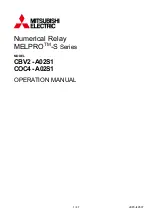
Event Number
Event channel
Event block name
Event Code
Description
6721
105
CIN2
1
Open
6722
105
CIN2
2
Close
6723
105
CIN2
3
Bad
6784
106
CIN3
0
Intermediate
6785
106
CIN3
1
Open
6786
106
CIN3
2
Close
6787
106
CIN3
3
Bad
6848
107
CIN4
0
Intermediate
6849
107
CIN4
1
Open
6850
107
CIN4
2
Close
6851
107
CIN4
3
Bad
6912
108
CIN5
0
Intermediate
6913
108
CIN5
1
Open
6914
108
CIN5
2
Close
6915
108
CIN5
3
Bad
5.4.4 Auto-recloser (79)
Auto-reclosing means a coordinated de-energization and re-energization of overhead lines (both
transmission and distribution). Its purpose is to clear transient and semi-permanent fault causes from
the line and automatically restore the supply to the line. These types of faults account for approximately
80...95 % of all faults found in transmission and distribution networks. The majority of these fault types
can be cleared with high-speed auto-reclosing, while the rest can be cleared with delayed auto-
reclosing by de-energizing the faulty line for a longer period of time.
Only a minority of overhead line faults are of the permanent type which require maintenance or repair
in the actual fault location. This type of fault include lightning striking the line, a tree branch touching
the line, an arc caused by animals, and a short-circuit caused by some other object touching the line. If
the fault is permanent (e.g. a broken insulator or a fallen tree leaning on the overhead line), the auto-
recloser cannot clear the fault and the faulty feeder is locked and prevented from closing until the
cause of the fault is repaired in the actual fault location. Also, when a fault cannot be cleared by auto-
reclosing the line, any close-distance short-circuits should avoid initiating the auto-recloser because
that would only cause unnecessary stress for the lines and the circuit breakers. Similar situations also
rise in mixed networks since cable network faults cannot be cleared with the auto-recloser. The
function must therefore be aware of the fault location before applying the auto-recloser to the faulty
line.
Auto-recloser as application
The main principle of the auto-recloser is to de-energize the faulty line and the fault location so
the cause of the fault can drop out from the line. When the line is energized and an object either
touches the line or drops onto the line, the current starts to flow through the object either to the ground
or between the phases. This causes the surrounding air to heat and ionize, and it starts to operate as a
conductor between the energized phase(s) and the ground causing an arc to ignite.
A
AQ
Q-S215
-S215
Instruction manual
Version: 2.04
140
Содержание AQ-S215
Страница 1: ...AQ S215 Bay control IED Instruction manual...
Страница 249: ...Figure 7 4 151 Example block scheme A AQ Q S215 S215 Instruction manual Version 2 04 248...
Страница 269: ...Figure 8 13 172 Device installation A AQ Q S215 S215 Instruction manual Version 2 04 268...
Страница 270: ...Figure 8 13 173 Panel cutout dimensions and device spacing A AQ Q S215 S215 Instruction manual Version 2 04 269...
Страница 287: ...10 Ordering information A AQ Q S215 S215 Instruction manual Version 2 04 286...
















































